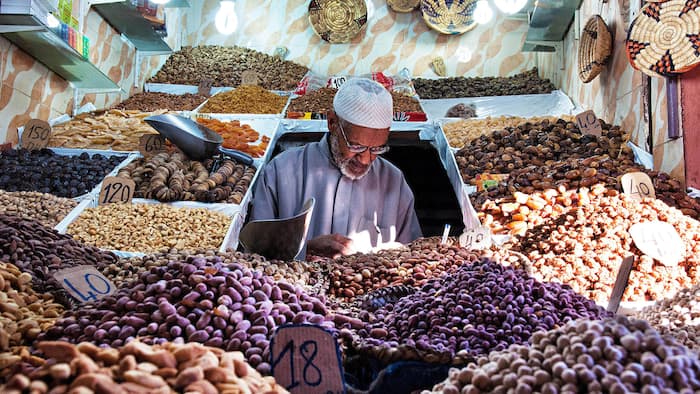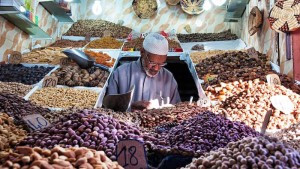Financial Times
A stall in the souk of the medina © Getty
When American writer and long-time Morocco resident Paul Bowles visited Marrakesh in 1961, he discovered a town painted with a “wash made of the pink earth on which it rests” and filled with dusty expanses and palm gardens.
Today the pink walls remain but “la ville rose”has morphed from a dusty backwater into Morocco’s second-biggest city. Set against the spectacular backdrop of the Atlas Mountains, it has managed to retain an easy-going charm and edgy exoticism that make it a magnet for visitors from around the world.
The city is roughly divided into three parts: the walled medina — home to labyrinthine souqs, hidden mansions and historic sites; a substantial French-built new town, known as Guéliz; and the Palmeraie, a 8km-long palm-filled oasis at the city’s northern edge. Shopping, nightlife and restaurants are concentrated in the medina and Guéliz. Resort hotels are located in the Palmeraie.
COP 22 has given the authorities an excuse for a citywide spruce-up. New highways have been built, infrastructure has been upgraded, solar-powered street lights installed and pink walls re-rendered. Smart new cabs with COP 22 logos now ply the streets alongside somewhat shabbier share-taxis used by ordinary Marakshis (the local name for the city’s inhabitants).
The conference will be held at a 30 hectare site adjacent to Bab Ighli, on the town’s southern edge. Delegates will have access to electric cars and minibuses to ferry them back and forth from key points in the town
Those looking for a break from the proceedings are spoilt for choice. Wandering the winding streets of the medina is one of the joys of Marrakesh, and a well-enforced ban on unofficial guides means the aggressive touts that used to harass tourists have gone.
The city may not have as many historic sites as some others in Morocco, but a number of them are clustered inside the old city walls not far from the conference site. Highlights include the ornately-decorated Saadian tombs, which date back to the 16th century; the ruined Badi palace, with a spectacular 90m long pool and sunken gardens; and the alleyways of the Mellah, the historic Jewish quarter. A little further away is the Ben Youssef Medersa, a religious school established in the 14th century which has echoes of the Alhambra in Spain.
The medina’s spiritual — if not physical — centre is the famous Djemaa el-Fna. A vast, chaotic square filled with market stalls, Berber hawkers, snake charmers, musicians playing exotic instruments and the aroma of grilled meat — it is an anarchic emblem of the city that cannot be missed.
Passages off the north side of the square lead into Marrakesh’s colourful souqs. Morocco nurtures its handicrafts — there is even a ministry devoted to artisanship — and their range and quality is on exuberant show in the souq’s winding alleys and colourful stalls. Suede babouches (slippers), embroidery, carpets, leather goods, wood and metalwork and clothing are mostly sold in dedicated alleys or sections. Bargaining is expected and is part of the fun.
The city’s rich tradition of artisanship has attracted Moroccan and European designers, who have also made their mark — most famously Yves St Laurent, who bought the park of Jardin Majorelle in the Guéliz district to prevent it from being sold to a hotel developer. The east-west cross-fertilisation can be seen in some parts of the souk — in the little boutiques of Souk Cherifa for example — but especially in the shops of Guéliz, where chic emporia sell homewares and clothes with a modern twist on Moroccan tradition. A perennial favourite is 33 rue Majorelle, recently featured in the FT, but there are many more.
Food in Marrakesh is as varied as the offerings in the souk. Many of the city’s riads(old mansions or houses that have been turned into boutique hotels) offer Moroccan or European-Moroccan fusion dishes to non-residents if they call ahead. In the heart of the souk there is a profusion of rooftop cafés and restaurants with good food and cool drinks for recovering from all the bargaining.
The fashion crowd’s long love affair with Marrakesh has also helped foster a lively, atmospheric nightlife. COP 22 delegates may not have time to paint the town a deeper shade of red, but they could try to have sundowners in the elegant La Mamounia, Marrakesh’s famous grand hotel. Otherwise there are cocktail bars, lounges and throbbing nightclubs dotted around the city.
Finally, there is the age-old Marakshi pleasure of sipping sweet mint tea on a rooftop under the stars. While the dusty expanses of 50 years ago have disappeared, some things in the pink city remain unchanged.








